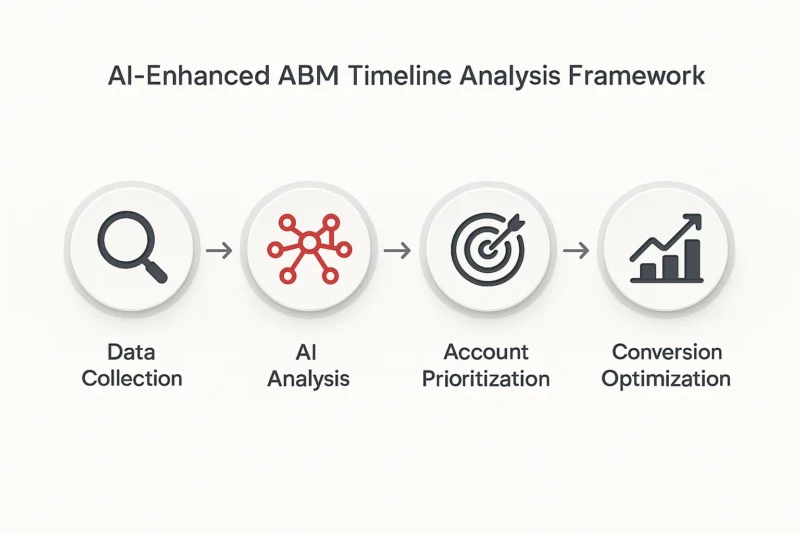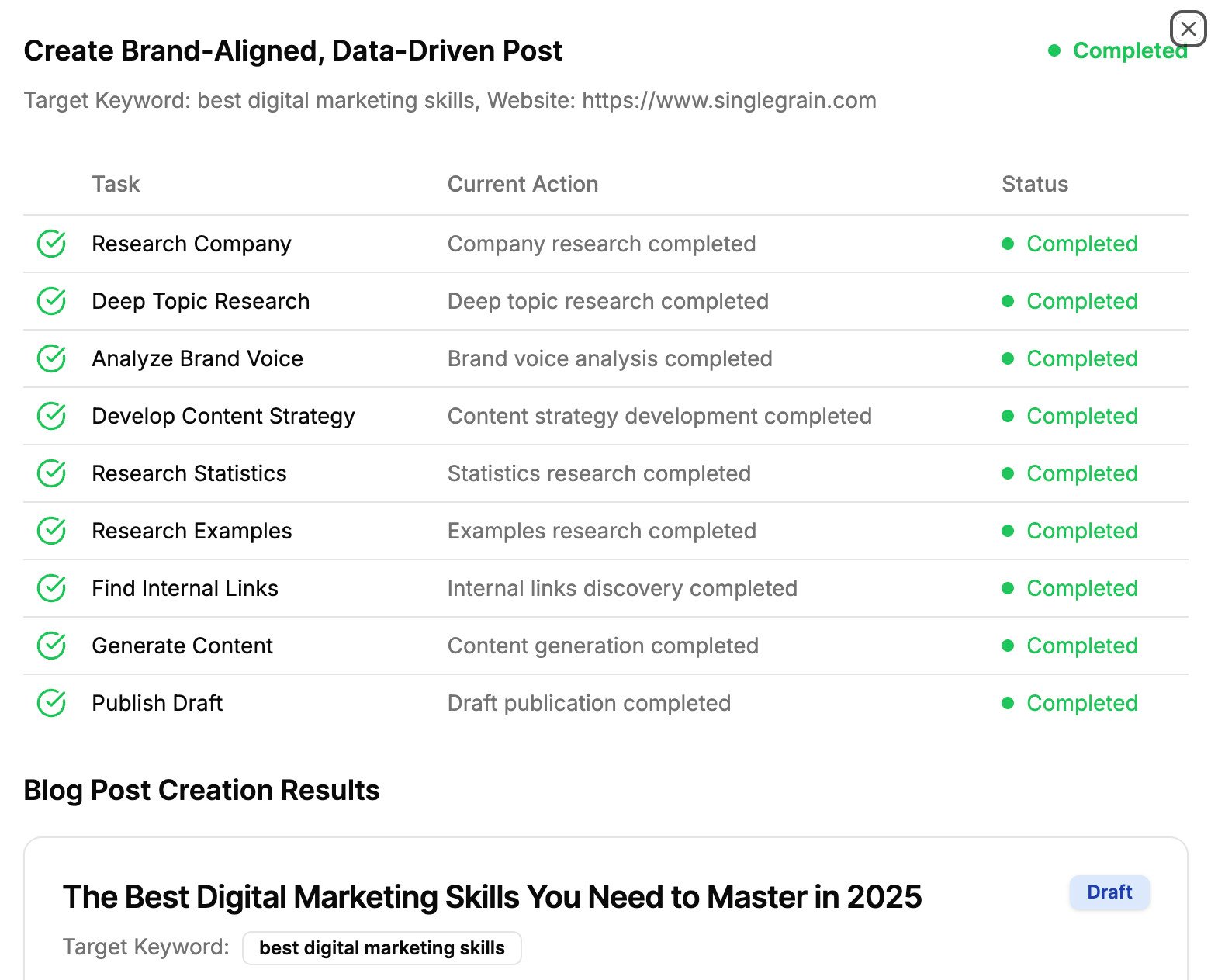Your HubSpot CRM contains a goldmine of account intelligence that most marketing teams barely scratch the surface of. Every email interaction, website visit, document download, and sales call creates data points that, when analyzed through an AI lens, reveal powerful patterns about account buying behavior and deal velocity.
The challenge isn’t data collection. HubSpot excels at capturing comprehensive account timelines. The real opportunity lies in applying artificial intelligence to transform those raw engagement histories into predictive insights that can slash your sales cycles and dramatically improve ABM conversion rates.
Key Takeaways
- AI transforms HubSpot timeline analysis from manual pattern recognition into predictive intelligence that can identify buying signals, micro-conversions, and accounts primed for sales outreach that humans typically miss in complex engagement data
- Companies using AI-enhanced ABM strategies report 208% increases in marketing-generated revenue by focusing resources on accounts demonstrating genuine buying intent rather than spreading efforts across unqualified prospects
- Successful implementation requires bi-directional data flow between HubSpot and AI tools to ensure sales, marketing, and customer success teams all benefit from AI-generated account intelligence synced back to the CRM
- AI-powered timeline analysis directly impacts deal velocity and conversion rates with real-world examples showing 30% reductions in sales cycle length and 25% growth in marketing-sourced pipeline
- The five-phase framework for analyzing HubSpot account timelines with AI for ABM includes data centralization, pattern recognition, predictive scoring, automated response triggering, and continuous learning optimization
TABLE OF CONTENTS:
Why AI Is Now Table-Stakes for ABM Analysis
The ABM landscape has shifted dramatically in 2025. According to recent industry research, 84% of marketers report leveraging AI and intent data to enhance personalization within their ABM campaigns. This isn’t just a trend. It’s becoming the baseline expectation for competitive ABM programs.
Traditional timeline analysis relies on manual pattern recognition, which means marketing ops teams spend countless hours trying to identify which accounts are showing buying signals. AI transforms this process by continuously analyzing engagement patterns, identifying micro-conversions, and surfacing accounts that are primed for sales outreach.
The intelligence gap between AI-powered and manual timeline analysis has widened to the point where companies without sophisticated account scoring are essentially flying blind in their ABM efforts. Your competitors are already using these insights to prioritize their highest-value opportunities while you’re still sorting through spreadsheets.

Understanding HubSpot Account Timelines for ABM
HubSpot’s account timeline functionality provides a chronological view of every touchpoint between your company and target accounts. This includes email opens, website sessions, content downloads, form submissions, sales calls, and even uploaded documents like proposals or contracts. For ABM teams, these timelines represent the complete digital body language of your most important prospects.
However, raw timeline data presents three critical challenges that AI directly addresses. First, volume overwhelm, enterprise accounts can generate hundreds of touchpoints monthly, making manual analysis impractical. Second, pattern blindness, humans naturally miss subtle engagement shifts that indicate buying stage transitions. Third, attribution complexity. Determining which specific touchpoints drive pipeline progression requires sophisticated correlation analysis.
AI-enhanced timeline analysis transforms these challenges into competitive advantages. Machine learning algorithms can process vast engagement datasets, identify patterns invisible to human analysts, and provide clear attribution models that connect specific touchpoints to revenue outcomes.
“The difference between companies that succeed with ABM and those that struggle isn’t the quality of their target account lists. It’s their ability to read and respond to buying signals hidden in their engagement data.”
AI Tools and Technologies for Timeline Analysis
Several categories of AI tools can enhance your HubSpot timeline analysis capabilities. Intent data platforms like 6sense and Demandbase layer external buying signals onto your CRM data, providing context about accounts researching solutions in your category. Predictive analytics tools use machine learning to score accounts based on engagement patterns and demographic fit.
HubSpot’s native AI capabilities have expanded significantly, with their new AI-powered Customer Agent demonstrating impressive results. According to HubSpot’s latest announcements, their AI-powered Customer Agent resolves 50%+ of support tickets automatically and cuts time-to-close by nearly 40%. This showcases how AI can not only analyze timeline data but also act on insights to accelerate deal progression.
Document intelligence tools represent another powerful category. These AI systems can analyze uploaded sales documents, extract key account information, and automatically update timeline records with relevant details about decision-makers, pain points, and buying criteria.
| AI Tool Category | Primary Function | HubSpot Integration | ABM Impact |
|---|---|---|---|
| Intent Data Platforms | External buying signal detection | Bi-directional sync | Early-stage opportunity identification |
| Predictive Analytics | Account scoring and prioritization | Native dashboards | Resource allocation optimization |
| Document Intelligence | Automated data extraction | Timeline enrichment | Complete account context |
| Workflow Automation | Trigger-based actions | Native workflows | Real-time response to signals |
Step-by-Step Framework for AI-Enhanced Timeline Analysis
Phase 1: Data Centralization and Enrichment
Begin by ensuring all account touchpoints flow into HubSpot. This includes not just marketing automation and sales activities, but also customer support interactions, product usage data, and third-party intent signals. AI tools require comprehensive datasets to identify meaningful patterns, so data completeness directly impacts analytical accuracy.
Phase 2: AI-Powered Pattern Recognition
Deploy machine learning algorithms to analyze engagement sequences and identify behavioral patterns that correlate with deal progression. This includes micro-engagement analysis (time spent on pages, document sections accessed), engagement velocity changes (frequency increases that signal active evaluation), and multi-stakeholder involvement patterns (new contacts from target accounts joining conversations).
Phase 3: Predictive Scoring Implementation
Develop AI-driven scoring models that combine engagement patterns with firmographic data to predict account conversion likelihood. These models should weight recent activities more heavily than historical engagement and account for buying stage progression indicators.
Phase 4: Automated Response Triggering
Create intelligent workflows that automatically respond to AI-identified buying signals. When accounts cross defined engagement thresholds or demonstrate specific behavioral patterns, the system should trigger personalized outreach, content delivery, or sales notifications.
Phase 5: Continuous Learning and Optimization
Implement feedback loops that allow AI models to learn from successful and unsuccessful conversions. This includes analyzing which engagement patterns most accurately predicted closed deals and adjusting scoring algorithms accordingly.
Revenue Impact of Precise Timeline Analysis
The financial implications of AI-enhanced timeline analysis extend far beyond operational efficiency. Industry data reveals that companies using ABM strategies have experienced a 208% increase in marketing-generated revenue. This dramatic improvement stems from the ability to focus resources on accounts demonstrating genuine buying intent rather than spreading efforts across unqualified prospects.
AI-powered timeline analysis amplifies this revenue impact through several mechanisms. First, velocity optimization, by identifying accounts that are actively evaluating solutions, sales teams can prioritize their highest-probability opportunities. Second, expansion intelligence, AI can detect signals indicating existing customers are ready for upsell or cross-sell conversations. Third, churn prevention. Engagement pattern changes often precede customer retention issues, allowing proactive intervention.
The compound effect of these improvements creates exponential rather than linear revenue growth. When your sales team focuses exclusively on AI-qualified accounts, their close rates improve dramatically while their sales cycles compress significantly.
Real-World Applications and Case Studies
Multiple B2B SaaS firms working with ARISE GTM have demonstrated the power of AI-enhanced timeline analysis. By integrating HubSpot CRM with AI-driven ABM platforms like RollWorks and 6sense, these companies pushed engagement data and predictive intent signals back into their HubSpot account timelines. The result: marketing-sourced pipeline grew 25%, and accounts exposed to RollWorks ads progressed through HubSpot deal stages significantly faster than non-engaged accounts.
Caterpillar provides another compelling example of AI-powered timeline analysis driving measurable results. Facing traditionally long sales cycles in heavy equipment manufacturing, they needed to focus reps on in-market buyers and shorten time-to-close. By adopting 6sense Revenue AI to surface predictive account insights and intent signals inside HubSpot, they cut average sales cycle length by 30%.
The Demandbase-HubSpot integration represents another successful approach to unified timeline intelligence. Organizations using this bi-directional sync report tighter sales-marketing alignment, faster campaign execution, and greater ability to prioritize high-value accounts thanks to real-time, AI-powered timeline insights.

Implementation Best Practices
Successful AI-enhanced timeline analysis requires careful attention to data quality and integration architecture. Start by auditing your current HubSpot data completeness. Gaps in contact information, missing activity records, or inconsistent property values will limit AI effectiveness. Establish data governance protocols that ensure consistent information capture across all customer-facing teams.
Integration planning should prioritize bi-directional data flow between HubSpot and your AI tools. Many companies make the mistake of treating their CRM as a data endpoint rather than a central intelligence hub. The most effective implementations sync insights back to HubSpot so that sales, marketing, and customer success teams all benefit from AI-generated account intelligence.
Change management represents another critical success factor. AI-enhanced timeline analysis will surface insights that challenge existing assumptions about account prioritization and resource allocation. Prepare your teams for data-driven decision making by providing training on interpreting AI-generated scores and recommendations.
For companies looking to accelerate their AI-powered ABM implementation, specialized platforms can provide immediate value. If you’re ready to transform your account engagement strategy with personalized, AI-driven campaigns that integrate seamlessly with your existing HubSpot workflows, consider getting a comprehensive assessment of your current ABM setup. Get a Free Audit to identify specific opportunities for AI enhancement in your account-based marketing program.
Measuring Success and ROI
Effective measurement of AI-enhanced timeline analysis requires both leading and lagging indicators. Leading indicators include engagement score improvements, account prioritization accuracy, and sales team adoption rates. These metrics provide early signals that your AI implementation is generating valuable insights.
Lagging indicators focus on business outcomes: shortened sales cycles, improved conversion rates, increased average deal values, and overall pipeline velocity. The most sophisticated ABM teams create attribution models that connect specific AI-generated insights to closed revenue, enabling precise ROI calculations.
Dashboard design plays a crucial role in measurement success. Create executive-level dashboards that highlight key performance indicators while providing drill-down capabilities for operational teams. Include both absolute metrics (total pipeline influenced by AI insights) and relative metrics (performance comparison between AI-scored and traditional accounts).
Building Your AI-Enhanced ABM Foundation
The convergence of AI and account-based marketing represents more than a tactical upgrade. It’s a fundamental shift in how B2B companies identify, engage, and convert high-value prospects. As we advance through 2025, the gap between AI-powered and traditional ABM approaches will continue widening, making early adoption a competitive necessity rather than an advantage.
Your HubSpot account timelines contain the raw materials for this transformation. The question isn’t whether to implement AI-enhanced analysis, but how quickly you can deploy these capabilities to capture market share from slower-moving competitors. Start with data consolidation, layer in predictive analytics, and gradually expand into automated response systems.
The companies that master AI-enhanced timeline analysis today will define the ABM landscape tomorrow. They’ll win deals faster, close larger contracts, and build sustainable competitive moats through superior account intelligence. The technology exists, the integration pathways are established, and the ROI is proven. The only remaining variable is your commitment to transformation.
For additional insights on maximizing your ABM technology stack, explore our comprehensive guide on what is account-based marketing and discover emerging trends in AI-powered ABM that are reshaping the B2B marketing landscape.
Ready to turn your HubSpot data into a revenue-generating machine instead of watching competitors win deals faster?
Frequently Asked Questions
-
What specific AI tools integrate best with HubSpot for timeline analysis?
Intent data platforms like 6sense and Demandbase offer bi-directional sync with HubSpot, while predictive analytics tools provide native dashboard integration. Document intelligence tools can automatically enrich timeline records, and HubSpot’s own AI-powered Customer Agent resolves 50%+ of support tickets automatically.
-
How does AI-enhanced timeline analysis impact sales cycle length?
Companies implementing AI-powered timeline analysis report 30% reductions in average sales cycle length by identifying accounts actively evaluating solutions. AI helps sales teams prioritize highest-probability opportunities and respond to buying signals in real-time.
-
What data quality requirements are necessary for effective AI timeline analysis?
AI tools require comprehensive datasets including all account touchpoints, complete contact information, consistent activity records, and accurate property values. Gaps in data completeness directly limit AI effectiveness, so establishing data governance protocols across all customer-facing teams is essential.
-
How do I measure ROI from AI-enhanced ABM timeline analysis?
Track leading indicators like engagement score improvements and account prioritization accuracy, plus lagging indicators such as shortened sales cycles and improved conversion rates. Create attribution models connecting AI-generated insights to closed revenue for precise ROI calculations.
-
What are the main challenges of manual timeline analysis that AI solves?
Manual analysis faces three critical challenges: volume overwhelm from hundreds of monthly touchpoints, pattern blindness where humans miss subtle engagement shifts, and attribution complexity in determining which touchpoints drive pipeline progression. AI transforms these challenges into competitive advantages through automated pattern recognition.
-
How should I prioritize which AI capabilities to implement first?
Start with data consolidation to ensure all touchpoints flow into HubSpot, then layer in predictive analytics for account scoring. Gradually expand into automated response systems and workflow triggers as your team adapts to data-driven decision making.
-
What results can I expect from implementing AI-enhanced ABM strategies?
Companies report 208% increases in marketing-generated revenue when using AI-enhanced ABM strategies. Real-world implementations show 25% growth in marketing-sourced pipeline and significantly faster deal progression through sales stages compared to traditional approaches.





